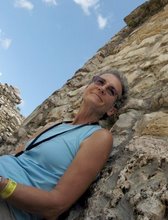
If you visit the Palenque Palace, chances are good that you will pass through the Tower Court. House E, the building to the east of the court is believed to have been the royal quarters of Pakal the Great. Here is Linda Schele's drawing of the Oval Tablet inside House E.
 Since one of my goals is to assess the impact of the tourist traffic on the palace building, the first thing I have do is to figure out a way to estimate how many tourists actually climb up to visit it. There are several access stairs that lead to it, so if I were to count everyone that uses the stairs, I would have to be in 3 places at once. Instead, I am using House E visitation as “proxy” count. This means that I will use these numbers to extrapolate how many are climbing the Palace structure.
Since one of my goals is to assess the impact of the tourist traffic on the palace building, the first thing I have do is to figure out a way to estimate how many tourists actually climb up to visit it. There are several access stairs that lead to it, so if I were to count everyone that uses the stairs, I would have to be in 3 places at once. Instead, I am using House E visitation as “proxy” count. This means that I will use these numbers to extrapolate how many are climbing the Palace structure. 



Did you know that the Palace may have had toilets? From my vantage point on the stairs, I have noticed that most of the people who visit the court have a guide with them and the guide always, without fail, brings them over to the two holes in the floor on either side of the west stairs. What are these holes? There is archaeological evidence that they might have been toilets. The guides love to give their demonstrations to show how these devices might work and then they squat into “la posición”, encouraging the visitors to do the same. Above you see a series of “las posiciónes” over the men's "toilet".
 La mujeres posición para el sanitarios
La mujeres posición para el sanitarios

And others just gaze down into the hole, expecting to see -- I don't know what.




1 comment:
Post a Comment